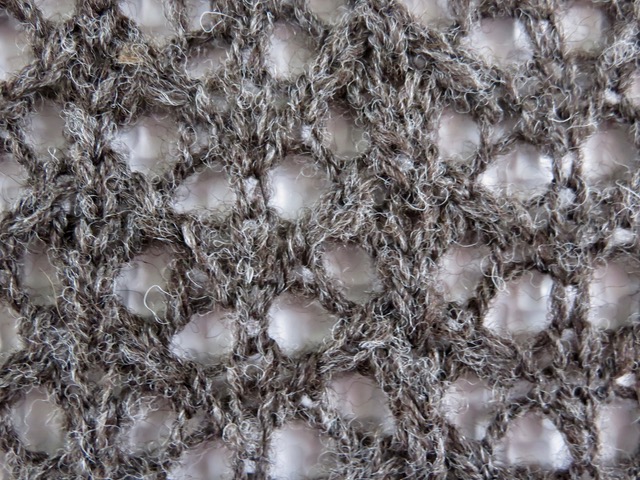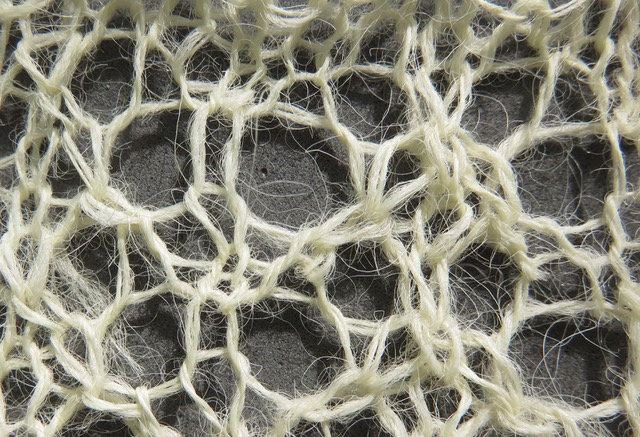Spinning for Lace: A Test
Words and Photos by Barbara Bundick
My favorite default yarn is, to put it mildly, frog hair. I spin fine. Lucky for me, I also love to knit lace. The 2 go together quite handily.
I’ve heard a number of old wives’ tales about the best yarn for lace knitting. First, 2-ply yarn is supposedly better than 3-ply yarn. The 2 strands in a 2-ply yarn push against each other. The yarn, by its own wont, keeps lace holes open and, dare I say it, lacy. A 3-ply yarn, on the other hand, is rounder than a 2-ply yarn, providing for better stitch definition. The old wives will tell you, “Knit lace with a 2-ply yarn. Knit cables or stockinette with a 3-ply yarn.”
The make-up of the yarn also matters, even when everything is wool, such as which of the 2 major methods of prepping wool is used. Combing aligns all the fibers so they’re neatly parallel, while carding mixes all the fibers up higgledy-piggledy. Combed fiber is sleek. Carded fiber will keep you warm in winter.
Then there’s the wool. To grossly oversimplify, wool comes in at least 3 varieties: fine, medium, and long. Fine wools, such as Merino, are naturally short stapled, with very tight crimp, and average around 20 microns in diameter. Longwools average closer to 33 microns, with a staple length that can be as long as a foot. A classic longwool staple is lustrous and wavy. Medium wools fall neatly in between.
Setting up the Experiment
So what makes the best yarn for lace knitting? I put the old wives’ tales to the test by preparing 12 samples. I started with 3 wools: Merino, the classic fine wool; Montadale, a medium wool developed in the U.S.; and Cotswold, a traditional longwool and the basis for the British wool trade. I combed some of each and carded some of each and spun 4 yarns from each: a 2-ply combed, a 3-ply combed, a 2-ply carded, and a 3-ply carded. I knit each yarn into a lace swatch – and voilà! I could figure out if the old wives were right.
I immediately encountered a problem. I used Merino and Montadale from fleeces I’d purchased. I knew the fiber was sound and would spin well. However, I was not happy with the Cotswold I received. Perhaps because it was lambswool, it did not have the luster and curl I had fantasized. The fiber was matte white with a light yellowish tinge. Fortunately, the Cotswold spun better than I expected, so I suspect my ultimate results are reasonably reliable. However, the next time I encounter the kind of longwool locks that I first envisioned, I may repeat the longwool part of the test.
Prepping and Spinning
Combing and carding went about as expected. The Merino, a greasy fleece to begin with, did not wash fully clean. The trace of residual lanolin made no difference in the combing. In carding, though, it did tend to hold the rolag together tightly, almost as though I’d made a puni. All residual grease washed out when I washed the yarn. The Montadale, ever obliging, and the Cotswold, with a little grumbling, all combed and carded without difficulty.
Yes, I handcarded Cotswold, even though the staples were over 3 inches long. Longwools can be carded, albeit carefully. They sometimes even benefit from the extra air. I once tried spinning some combed Gotland locks, but the fiber kept trying to felt in my hands. I carded the Gotland, adding air, and the fiber became spinnable. While combing remains the preferred method of preparing longwools, carding is worth a try.
I spun all my yarn on a top whorl drop spindle because, heck, I love spindles. My spindle spinning is neither pure worsted nor pure woolen, but a mix of each. My finished combed yarns, therefore, did not have all the sleekness of a pure worsted draft – just most of it. The carded yarns didn’t inhale as much air as they would have if I had spun standard woolen. The difference between the preparations still showed in the yarns and the final swatches.
The combed Cotswold taught me a valuable lesson. It wanted, insisted really, on being drafted from the butt end. Wool has scales that point towards the tip. When you spin from the tip, you’re pulling against the scales. When you spin from the butt, the scales remain closed. The Cotswold drafted sleek as silk when I spun it from the butt end. When I spun it from the tip, it balked. The Merino and the Montadale were also happier spun from the butt end. Lesson learned. (Hint: If you’re not sure which end is which, rub the combed fiber between your thumb and your first finger. Your fingers will naturally move towards the tip end. Start drafting at the other end.)
Knitting
Yarns plied, it was time to knit. The yarns were close enough in wraps per inch that I decided to knit them all on the same pair of US size 3 needles. I chose a traditional lace pattern called the Spider Stitch, which is based on a 6-stitch repeat over 4 rows:
Row 1: K1, k2tog, *yo, k1, yo, ssk, k1, k2tog*; repeat between asterisks, then finish with ssk, k1.
Rows 2 and 4: Purl.
Row 3: K2tog, yo, *k3, yo, slip2-k1-psso, yo*; repeat between asterisks, then finish with k3, yo, ssk.
Results
The results both proved and disproved the old wives’ tales. Some differences were obvious and to be expected. The 3-ply yarns were thicker than the 2-ply yarns. The carded yarns were fuzzier than the combed ones.
I will happily challenge the old wives, however, about the superiority of a 2-ply yarn for lace. I could see no evidence that the lace holes in any of the 2-ply swatches were larger or rounder than the holes in the corresponding 3-ply swatch. The 3-ply yarns, however, did have slightly better stitch definition. Thus, the key benefit of knitting lace with a 2-ply yarn is the fineness of the yarn. If your goal is to pull your shawl through a wedding ring, why crowd the ring with an extra ply? The carded yarns were also slightly thicker than the combed yarns. Because carding adds air, carded yarns puff when they’re washed. The puffing, especially with the carded Montadale, somewhat obscured the laciness of the lace.

If your goal is elegance, use a combed yarn. If your goal is warmth, however, a 3-ply carded medium wool is well worth considering. Of the 3 wools, the Merino, in its combed, 2-ply form, produced the finest, softest lace. I could knit a wedding ring shawl with that stuff.

The Montadale, even combed, has a natural fuzziness and bounce that keeps it out of wedding ring territory. But a soft warm wrap? Pull out the Montadale. While I was disappointed with the Cotswold in general, the 2-ply combed yarn did knit into a showy lace.

The fiber was a bit scratchy, with no elasticity. It would not work for next-to-the-skin wear. A 2-ply combed longwool scarf, however, would be just the thing for dressing up a winter coat.
All wools and all prep methods and all yarns have their uses, even for lace. If there’s any lesson I learned from this experiment, it’s don’t spin and knit to please the old wives. Experiment, and then do as you please.
Barbara Bundick has been knitting for 50 years and spinning for 20. She is a graduate of the Olds College Master Spinner Program. She lives in northern Illinois with her husband, one daughter, her daughter’s two cats, and more wheels, spindles, knitting needles, and stash than are worth mentioning.





Leave a Reply
Want to join the discussion?Feel free to contribute!